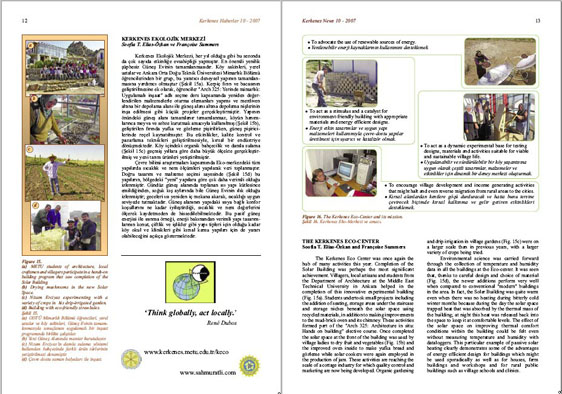THE KERKENES ECO-CENTER
Soofia T. Elias-Özkan and Françoise Summers
The Kerkenes Eco Center was once again the hub of many activities this year. Completion of the Solar Building was perhaps the most significant achievement. Villagers, local artisans and students from the Department of Architecture at the Middle East Technical University in Ankara helped in the completion of this innovative experimental building (Fig. 15a). Students undertook small projects including the addition of seating, storage areas under the staircase and storage niches beneath the solar space using recycled materials, in addition to making improvements to the mud-brick oven and its chimney. These activities formed part of the "Arch 325: Architecture in situ: Hands on building" elective course. Once completed the solar space at the front of the building was used by village ladies to dry fruit and vegetables (Fig. 15b) and the improved oven inside to make yufka bread and gözleme while solar cookers were again employed in the production of jam. These activities are reaching the scale of a cottage industry for which quality control and marketing are now being developed. Organic gardening and drip irrigation in village gardens (Fig. 15c) were on a larger scale than in previous years, with a larger variety of crops being tried. Environmental science was carried forward through the collection of temperature and humidity data in all the buildings at the Eco-center. It was seen that, thanks to careful design and choice of material (Fig. 15d), the newer additions perform very well when compared to conventional "modern" buildings in the area. In fact, the Solar Building was quite warm even when there was no heating during bitterly cold winter months because during the day the solar space trapped heat that was absorbed by the thermal mass of the building; at night this heat was released back into the space to keep it at comfortable levels. The effect of the solar space on improving thermal comfort conditions within the building could be felt even without measuring temperature and humidity with dataloggers. This particular example of passive solar heating clearly demonstrates some of the advantages of energy efficient design for buildings which might be used sporadically as well as for houses, farm buildings and workshops and for rural public buildings such as village schools and clinics.



